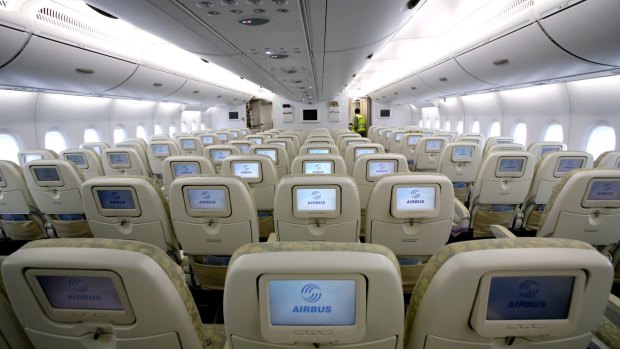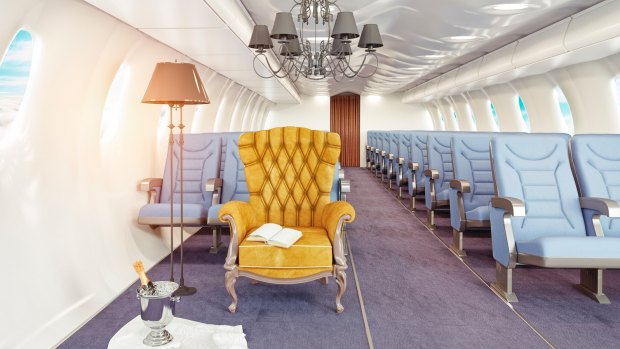This was published 8 years ago
The best plane seats in economy class and how to get them
By Michael Gebicki
Airline seating started off as an afterthought. Wicker armchairs were commonly used to seat passengers on aircraft in the 1920s. Aircraft interiors went through a purple patch in the 1930s, a time when Britain's Imperial Airways stitched together far flung corners of the Empire. Photos from the time show chaps lounging in overstuffed armchairs but air travel was strictly for toffs and the airline industry was realising its future lay in catering to the masses, and that meant packing more bodies into fuselages.
Aluminium-framed seats came in with such venerable aircraft as the Douglas DC-3 in the 1930s and they remain standard, but there's a world of difference between the then and now of aircraft seating.
While the backrest was once anything from 75-100cm wide, most of it foam padding, the latest slimline seats are about 50cm across. Seat pitch in a standard economy seat has shrunk by about 5cm on a modern aircraft compared with a Boeing 707 aircraft of the 1960s.

Choose your seat wisely in economy.Credit: AP
Even within economy all seats are not created equal. There are exit row seats with more leg room, seats which by some quirk of aircraft design have no seat in front of them, bulkhead seats and seats in separate cabins that are off limits to younger passengers, as aboard Scoot and Air Asia, and airlines have it sussed. A few years back they began to monetise these modest advantages and now they're all yours, for a fee. Suppose you don't want to pay, there are still a few ways to tilt the comfort factor in your favour when you're flying back of the bus.
The Ace for Space
Seats in the back of the plane are bumpier, you're gong to be almost the last off and it's noisier because you're behind the engines. You might be near the galley and toilets which are clattery and high traffic. You might be among the last to get a meal service and that can mean you get to eat the stuff that nobody else wants. For all those reasons these are the wallflowers, the last seats to be filled, but for those who can live with the downsides there's a decent chance of an empty seat beside you. For fleet-of-foot flyers who like to eyeball vacant rows and move as soon as the doors close, back of the plane is ideal. Another plus – you'll probably be among the first to be called for boarding, and more likely to score an empty overhead bin.

Even within economy, all seats are not created equal. Credit: iStock
The Noise Avoider
Newer aircraft have quieter cabins. In general though, in front of the wings is prime since engine noise is deflected backwards, and aisle seats are said to be quieter than window. Bulkheads are where the bassinets attach and so small babies present and therefore more chance of crying. Especially on descent since it's much harder for infants to equalise pressure in their inner ear, and a whole lot more painful than what most adults experience.
The Bulkhead Conundrum
Seats behind the bulkhead usually give you a few extra centimetres of leg room but it also means there's no possibility of stretching your legs out under the seat in front, which is a good option for taller flyers. Some flyers like to angle long legs up against the bulkhead but it's untidy, and for some reason it annoys flight crew. Bulkhead seating is a great choice for flyers who detest seat recliners since there's no seat in front to recline. That also means no seat to tuck things under so all your carry-ons will be in the overhead locker for takeoff and landing. The pull-out video screens that go with bulkhead seats are often smaller than seatback screens, especially on modern aircraft. The tray table for these seats is stored in the armrest, reducing seat width slightly.
The Nervous Flyer
As far forward as possible is reckoned to be less troublesome since it's smoother and quieter. Window or aisle seat is down to personal preference, for some the view is reassuring.
The Impatient Feeder
Food service usually starts at the front of the cabin but if you want to step up the pace, order a low-fat low-cholesterol or lacto-ovo vegetarian meal and you'll get yours before the food trolley rumbles down the aisle. Particularly effective if you're boarding late in the night and just want to eat quickly and sleep.
My Pick
In the back third of the economy cabin, aisle seat, but on the window side of the aisle rather than the central aisle if it's a twin-aisle aircraft. I've got noise cancelling headphones so engine shout is a whisper and I'll pre-order a special meal so I don't get stuck with the least favoured choice from the meal service.
See also: Airbus plans to create the perfect economy class space
Sign up for the Traveller newsletter
The latest travel news, tips and inspiration delivered to your inbox. Sign up now.